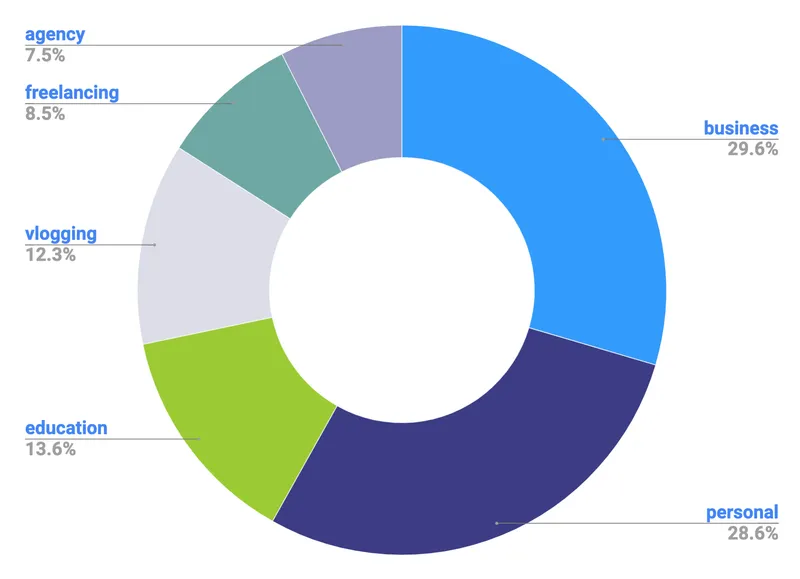[Product Roadmap] How browser-based video creation startup InVideo is making over 800,000 videos a month
In this week’s Product Roadmap, we feature InVideo, a platform that helps create videos across different browsers, and is now making over 800,000 videos a month.
Video content is becoming increasingly popular, and the pandemic has only accelerated the appetite for video content. According to Statista, as of 2018, 85 percent internet users in India watched video content online.
From well-established streaming players to marketing companies and social media platforms, we are seeing how both brands and influencers are fighting for attention by using video content.
But back in 2012, when Sanket Shah, Co-founder of , was at the University of Michigan, he realised the challenges associated with the video creation process while converting non-fiction books into 10 minute video summaries.

The InVideo Team
Identifying a gap, Sanket decided to start InVideo, a video creation and editing platform, along with Harsh Vakharia, and Pankit Chheda in 2017. The startup has built a video creation software in a browser that allows anyone to create professional and high-quality videos without any prior design skills.
Today, InVideo claims to be having over seven million users across 190 countries, and is creating over 800,000 videos every month.
Sanket says, the future of video creation is in the browser, across devices, and something that is collaborative and easy to use.
The product - how it works?
InVideo, which is a web-based software, offers a drag-and-drop interface along with a library of templates, stock photos, music, and videos to create professional-quality videos with ease.
However, the difficulty in using browsers to create videos is that they are not meant for everyone to design, and thus, to get the graphics and performance to create a video becomes a challenge on the browser and to sync them across devices.
Sanket says, “We use WebGL and WebAudio. We also use internal animation builders as it is tough due to lack of libraries and frameworks that can allow you to create video in the browser, primarily because video is very heavy on DPU (Data Processing Unit) and browsers don’t let you control the GPU (Graphics Processing Unit). So one has to write it on very low level APIs."
A user can buy different workflows and they can choose the right template. They can start from scratch if they want to follow traditional editing format, and they can easily create their video without requiring any professional skills, Sanket adds.

Video Length as shared by InVideo team
“With InVideo, it has been an interesting journey. As and when we discovered problems, we worked on providing potential solutions to create high quality content, and that’s when we concluded the future of video creation is in the browser,” explains Sanket.
Initially, the startup’s beta product found use cases in media houses like Reuters, CNBC, etc. Later, the startup realised there’s a large use case in the segment as the journalists might become content writers/creators in the future, and they can always use InVideo to create video content.
Launching on AppSumo
InVideo then decided to launch on AppSumo, and according to the founders, this launch went out to be the most-subscribed in AppSumo’s history.
Sanket says they asked users if the product fits for their use, and close to 60 percent said they’d be disappointed if they did not get to use InVideo.
“That’s how we went on to achieve product-market-fit (PMF) for InVideo. AppSumo has launched several products like Dropbox, Intercom, and Evernote. That’s how we started our journey on very horizontal use cases across the world,” says Sanket.
He adds that newsrooms are very dynamic and they create 10 to 12 videos per brand per day. The product thus evolved to find use cases in different segments, with the most game changing point in April 2019 when they opened it to the world.
“Video creation is fundamentally the same product for any use case. It’s about building the right kind of functionality and features that make the process less cumbersome,” adds Sanket.

Videos used by, as shared by InVideo
Multi-use case approach
Initially, the team was building natural language processing (NLP) tools on videos to make it simpler, and that’s when they got a call from Republic TV, and the team stitched everything together that was even earlier than the proof of concept.
“The first product was a very simple-to-use video creator that focussed on converting articles to videos (text-to-video). The first prototype took around two months to build, but it was very basic and we did not use WebGL then,” explains Sanket.
The product primarily helped validate the use cases. Sanket says the team constantly focussed on the net promoter score (NPS) as it is an excellent indicator of knowing whether people will use the tool or not.
“The NPS was constantly around 60. Also, in the early days, we would go to different newsrooms and actually sit with the journalists to understand what their problems were. So, it was more like building the product together with them, for them. Broadly, we have the same product today,” adds Sanket.
It was then they realised that to build a large company in this space, they had to target multiple use cases.
“There are several learnings -- who should the real user be, what leads to creating a gold standard video, and we also understand what will really get us there.”
“We have spent nearly 4.5 years doing this, so it is almost expected from us that we should know more about the business than anyone else. We understand user acquisition, churn, best technologies, etc., much better now. How to look at data, what kind of company you are building for, etc., compounds to understanding more about the business,” says Sanket.
While they were moving the core stack to WebGL + WASM and also building the core functionalities that were necessary, the team focussed on the segments where NPS + PMF was high.
“If Canva won because of templates (abstractions) and Figma won because of collaboration, they still had to build the core functionalities that Adobe Photoshop and XD offered, respectively. In all these segments, building core functionalities is difficult and video is the most difficult out of all of them,” says Sanket.
YourStory’s flagship startup-tech and leadership conference will return virtually for its 13th edition on October 25-30, 2021. Sign up for updates on TechSparks or to express your interest in partnerships and speaker opportunities here.
For more on TechSparks 2021, click here.
Edited by Megha Reddy


![[Product Roadmap] How browser-based video creation startup InVideo is making over 800,000 videos a month](https://images.yourstory.com/cs/2/a9efa9c02dd911e9adc52d913c55075e/invideo-1632213536117.png?mode=crop&crop=faces&ar=2%3A1&format=auto&w=1920&q=75)
![[Product Roadmap] How ImaginXP is helping universities make their students employable](https://images.yourstory.com/cs/2/a9efa9c02dd911e9adc52d913c55075e/PRM-1-1631622102840.png?fm=png&auto=format&h=100&w=100&crop=entropy&fit=crop)
![[Product Roadmap] How Uber's India tech centres are leveraging product thinking and technology to drive innovation](https://images.yourstory.com/cs/2/721b1c100eb911eb936a1114ea00a5c0/ProductRoadmap-30-1631091734226.png?fm=png&auto=format&h=100&w=100&crop=entropy&fit=crop)
![[Product Roadmap] Starting with SMS, how Netcore today manages close to 50 pc of Asia’s email traffic](https://images.yourstory.com/cs/2/a9efa9c02dd911e9adc52d913c55075e/PRM-1630391045610.png?fm=png&auto=format&h=100&w=100&crop=entropy&fit=crop)




